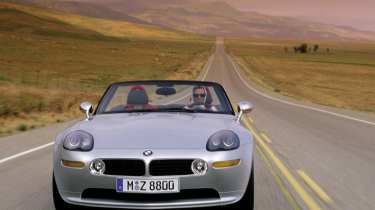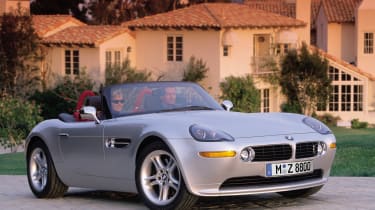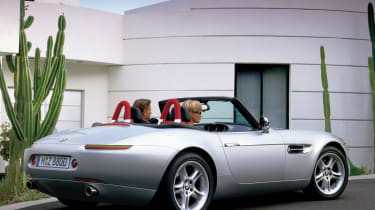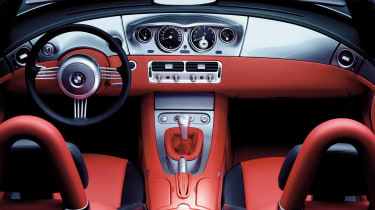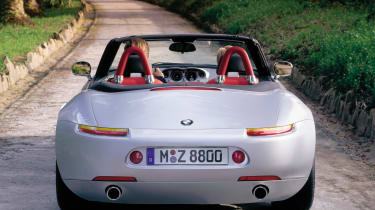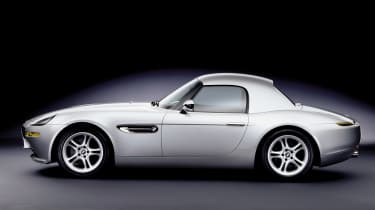BMW Z8: history, review and specs of an icon
Has a recent upsurge in interest seen the BMW Z8 transition from also ran to icon?
Being a star of the big screen doesn’t necessarily bring critical acclaim – witness the Bond-driven BMW Roadsters (Z3 and Z8) that had starring roles in GoldenEye and The World Is Not Enough. Neither were desperately revered for their dynamic abilities and didn’t receive fawning critical approval from the press, yet they both went on to find favour with their owners and today the Z8 has become something of a collector’s item with big money being paid for examples with low miles and perfect provenances.
> BMW M5 E28 - history, review and specs of an icon
We’ll gloss over the Z3’s quirky styling and ancient underpinnings and focus on the main event, the Z8 Roadster. This should have been the car to take BMW forward into the new millennium but what we got was something of a retro pastiche of the 507 that never quite hit the spot. It was a car with a bit of an identity crisis – was it a Californian cruiser, an autobahn weapon or a tack-sharp driving tool? Nobody really seemed to know.
The onward march of time seems to have been kinder to the Z8 than to some other machines that have had a less than stellar critical acclaim – is it the car’s styling, cracking V8 or limited production run that’s kick-started the Z8’s appreciation society? Collectors now covet the Z8 – 10 or 12 years ago these LHD-only machines were sitting unloved in specialists’ showrooms – but these days you’ll need at least £150k (or more for the very best examples) to join the club.
History
The Z8 was designed during the 1990s under the watchful eye of the Chris Bangle, the recently arrived head of BMW’s design department, although its retro lines were actually penned by Henrik Fisker. The precursor to the Z8 was exhibited at the 1997 Tokyo motor show as the Z07 Concept and it was actually two cars – a retro-styled roadster and a similarly nostalgic coupe.
The concept was a feast of design indulgence with its curving bodywork, wide stance and a flying buttress helmet fairing on the roadster and double-bubble roof on the coupe. There was no denying the similarities between the Z07 and the classic 507 of the Fifties. Looking at the cars side-by-side, the Z07 was a modern homage to the classic BMW and they shared numerous styling cues – the split front grille, the shape of the bumper and the bonnet, the side vents and the raised rear shoulder line. As far as modern interpretations went it was spot on, although at the same time it wasn’t the most coherent of shapes and lacked the 507’s ultimate style and grace.
Two years later in 1999 BMW unveiled the production-ready Z8 and the biggest shock was that it had barely deviated from the design of the concept at all. There had been a few tweaks here and there but perhaps the biggest deviation from the concept was that the production car would only be available as a Roadster with the equally dramatic coupe version not sanctioned for public consumption.
The Z8 had all the right ingredients – retro looks, the E39 M5’s 4941cc V8, a separate space frame chassis and aluminium bodywork – but it also had an eye-watering price tag in the UK of £86,650 and it was left-hand drive only. For a nigh-on £90k BMW its reviews from the press were decidedly lukewarm. It was almost as if the Z8 didn’t have a proper identity – it wasn’t entirely sure if it was meant to be a boulevard cruiser or a back road blaster and ended up being something of a Jack of all trades, and crucially, master of none.
> Five Star - 25 years of the BMW M5
Perhaps BMW missed a trick by limiting the Z8 to just one model? If the coupe version had also been launched BMW could have made a softer roadster for those more interested in cruising and a more hardcore, driver-focussed coupe for those looking for driving thrills. Ultimately BMW didn’t really have the production capacity to do this as the Z8’s chassis was made at its Dingolfing plant before being sent to Munich where its assembly was almost completely done by hand. As a result the Z8 took ten times longer to manufacture than a contemporary 3-series saloon.
In total BMW manufactured 5703 Z8s between 1999 and 2003 and if you think you’ve only ever seen a silver one that’s not surprising as 3182 of those cars were finished in the launch (and Bond) colour of Titanium Silver. Other hues included black (just over 1500 cars) Topaz blue, red and Stratus grey, along with nearly 125 cars painted by BMW’s Individual department.
Engine and transmission
Under the Z8’s retro bonnet you’ll find the S62 4941cc V8 from the E39 M5. No changes were made for its Roadster application and thus it develops 394bhp and 369lb ft of torque. It was BMW’s first M Power V8 and while it was obviously extensively modified for its M5 and Z8 applications it shared much of its architecture with the normal 4.4-litre V8 that could be found in the 540i and 740i of the era.
It retained the hydraulic self-adjusting tappets of the parent engine making it the first M power unit which didn’t require its shims redoing come major service time – just as well as there would have been 32 to do. It did, though, have plenty of the normal M touches like individual throttle butterflies (electronically actuated for the first time) along with bespoke pistons, crankshaft and conrods. Unlike the standard BMW V8 the S62 featured double Vanos (variable valve timing) which operated on all four hollow camshafts.
Despite extensive changes over the standard BMW 4.4-litre there were some cost cutting measures on the engine – it had the standard car’s cast iron exhaust manifolds for example, where all previous M engines had had bespoke works of art to expel their exhaust gases. It wasn’t hand-built either, being made at the normal BMW engine plant.
It was still a superb engine – tuneful, powerful, torquey – but in terms of specific output it was well down by normal M standards. The early ’90s 3.8-litre E34 M5 developed 88bhp per litre, the contemporary E46 M3 was up at 105bhp per litre, yet the S62 V8 could only muster 78bhp per litre.
The gearbox was also donated by the M5 – a Getrag six-speed manual – which was tough and precise, albeit with a slightly long throw, but perhaps the biggest talking point was the fact that BMW decided the Z8 could do without the limited-slip differential that was an intrinsic part of the M5’s make up.
Suspension, steering and brakes
The Z8 featured an all-aluminium space frame construction – unlike every other modern BMW – and it was chosen for its lightness, strength and impressive impact performance. The suspension used MacPherson struts and lower wishbones at the front with a five-link rear setup at the rear and wherever possible aluminium was used to keep weight down.
The brakes were taken from the BMW 750i and were more than up to the job of providing ample stopping power as they had been designed to slow a two-tonne executive leviathan. The steering, meanwhile, was rack and pinion - worthy of note as this was the first time that BMW had chosen not to use recirculating ball steering with a V8-powered car. The engine was mounted behind the front axle in order to help the Z8 achieve that all-important 50:50 weight distribution.
> BMW M1: history, reviews and specs of an icon
Interior
With its all-aluminium body looking like that of no other modern BMW it shouldn’t have come as a surprise that the Z8’s interior was somewhat off the wall, too. There was a retro-styled steering wheel with a slender rim supported by wire spokes and the dash itself was effectively split into two sections. The top half consisted of wraparound plastic sections with the instruments housed in a central binnacle that was angled towards the driver.
The lower dash section was finished in the same colour leather as the seats and even the roll over hoops were covered in the same material. The dash top itself was also leather… which made the large plastic panel which ran from one side of the dash to the other look even more incongruous than it should have done in an £86k car.
As you’d expect from a luxury roadster costing as much as the Z8 did, just about everything was standard. Electric leather seats, sat-nav (housed in the radio’s display that was hidden beneath a plastic panel in front of the gear lever), a 10-speaker stereo, xenons, anthracite headlining and air-con were among the standard appointments.
> BMW M Coupe (1998-2002) - review, specs and buying guide
On the road
Despite its extensive use of aluminium in its construction the Z8 tipped the scales at a not insignificant 1585kg – relatively portly for a two-seat roadster – but usefully lighter than the M5 which had donated its running gear and as a result the Z8 was certainly rapid. BMW claimed a 0-62mph time of 4.7sec and in a straight line it feels every bit as fast as the figures suggest. Being able to drop the hood at the touch of button also allows you to hear the V8 strutting its stuff and it goes through its full repertoire of off-beat V8 burble at idle to a voracious bellow as you approach the red line. It might be a slightly cut-price M engine, but it’s still glorious to sit behind.
Unfortunately the rest of the driving experience doesn’t quite live up to the V8. Again, all the right components are there – McPherson struts and wishbones up front and a multi-link rear end but on the road the front end has too much understeer –it’ll plough on in sharper corners and gently wash wide in faster sweepers. The rear wheels grip well but the lack of LSD means that transitions from grip to slip aren’t very progressive. Driven at seventh tenths it’s a very pleasant experience but getting more out of it than that isn’t very rewarding. In 2001 a Z8 was used as the medical safety car for MotoGP and it must have been a handful for the driver to put in tidy laps in a rapid fashion.
It does ride pretty well and with the hood up you’re well insulated from road noise and the best way to enjoy the car is to not to try and extract too much from it. It’s a great way to cruise around – you can be lazy and let the torque do the work or if you want to go faster you can stir the long-throw gear lever and go pretty rapidly in a straight line – just don’t expect it to be hugely rewarding on the twisty bits. It’s a good car, but one where the driving experience doesn’t quite match up to the dramatic looks.
> BMW M5 (F10) 2011-2016: review, specs and buying guide
Rivals
If you were after an indecently rapid drop top around the time when we were all worried that the millennium bug was going to bring about global computer meltdown your choices were relatively limited. Aston’s DB7 Volante ticked all the right boxes but even with a 6-litre V12 it was no quicker than the Z8 and perhaps didn’t have the chassis to beat the Z8 hands down either.
Ferrari’s 360 Spider joined the fray in 2000 and while it might not have had the retro styling it was every bit a match for the Z8 in performance while it was a better steer. Porsche’s 996 cabriolet would have offered drop top thrills in both normally-aspirated or Turbo forms and Stuttgart’s other manufacturer would have been ushering you in the direction of an Mercedes SL500 or SL600 depending on the size of your budget.
Ultimately UK sales of the Z8 were hampered by its LHD-only layout, a high price tag and perhaps we weren’t quite ready for a retro-styled Roadster back then. Today though retro is very much in vogue and the Z8 is now seen as more desirable than when it was new. It’s a funny old world sometimes…
Specs
| Engine |
V8, DHOC, 4941cc |
| Power |
394bhp @ 6600rpm |
| Torque |
369lb ft @ 3800rpm |
| Transmission |
Getrag six-speed manual |
| Wheels | 5.5in x 14in front and rear |
| Tyres |
245/45 WR18 front, 275/40 WR18 rear |
| Weight |
1585kg |
| Power-to-weight |
253bhp/ton |
| 0-60mph |
4.7sec (claimed) |
| Top speed |
155mph (claimed) |
| Price new |
£86,650 (1999) |
| Price now |
£150,000+ (2018) |
